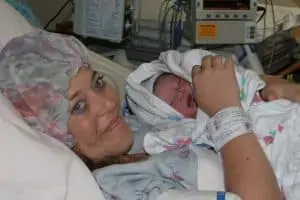It’s a bit fuzzy, but I do remember not sleeping very well after my c-section while still in the hospital. Part of it was my eldest, just a tiny cherub in the little crib they wheeled up next to my hospital bed.
Other things that contributed to my lack of sleep were:
1) Being in a hospital, which I hated.
2) Being in a hospital in China, which had the bonus of cultural and language differences.
3) Wanting REAL food (you can’t eat until you fart…read my post on that).
4) Only 8 channels on the TV, all in Chinese and not one of them with any dramas.
5) My mother-in-law was continually shuffling her feet around the room, and getting on my exhausted nerves, bless her heart.
With my youngest, I didn’t sleep until they turned the air conditioner down to freezing in our room after my husband screamed at the entire staff. They have a very different take on air conditioning there, even in July. Once they did that and administered more pain meds, I remember sleeping blissfully.
You’d think after major surgery; you’d be down for the count. And while you might not have the added excitement of having your c-section conducted in a foreign country with your mother-in-law making you nuts, you might not be able to sleep yourself.
What’s up with that?
The Reason It’s Hard to Sleep After a C-Section
An apparent reason is a pain. C-sections are definitely painful. You won’t feel a thing when you go under the knife. But once that first round of pain meds wears off, you’ll be yelling UNCLE! Sometimes this can be all you need to get that sleep.
But!
There’s something else you should be cautious of. During this time, you’re more prone to OSA (obstructive sleep apnea). This can make it hard for you to stay asleep once you do fall asleep.

OSA happens when the hormones in your body interfere with your airway muscles. That coupled with that residual baby bump is putting pressure on the airway. And coupled with those pain meds that you kinda-sorta need to not yowl away in pain 24/7, that puts you at higher risk. Experts tend to recommend sleeping with your upper body elevated during this tender time.
In the hospital, I used the bed itself to stay a bit elevated. You don’t need a massive incline, but enough of one will do the trick. And no, you don’t have to sleep like this forever.
Once the catheter comes out and you can get up and move, it’s the best thing for helping you recover, as is proper nutrition. However, sleep is an essential facet of healing after your c-section and getting into the right sleep position post-c-section is going to help tons.
Sleep Positions for After C-Section
We’re all different, and honestly, I’m a side-sleeper all my life. I was a side-lying breastfeeding mom, and after my c-section, once I was cleared to go home, I chose to sleep on my side.
That’s not to say I didn’t do all the following positions I’m about to list. They all have their moments. Here they are and why they’re good for your sleep after a c-section.
Back
In the hospital, that bed was awful and uncomfortable. I had it slightly elevated and lay on my back while there. At home, though, I found laying on my back harder because our bed didn’t raise and lower.
A word of caution: if your blood pressure is abnormal, your doctor will likely advise against you sleeping on your back. But for everyone else, this position avoids putting pressure on the incision. It’s much more comfortable if you put a pillow under the middle of your legs.
The biggest downside is trying to get up or sit up from this sleep position. It’s a challenge, one that might leave you wincing if you’re not careful.
Side

As far as side sleeping goes, doing so on your left side helps provide optimum blood flow and is better for digestion. My dad had always told me this whenever I had tummy trouble when I was younger. I almost always sleep on my left side because of it, but sometimes I sleep on my right side.
Pillows can add a little more support, plus this position is a lot easier to get up from. Just remember to exhale when you push yourself up.
Elevated
During the day when you need a break from lying down, propping yourself up with pillows is ideal. It’s a great way to read in bed, and if you’re still concerned about OSA, this sleep position after your c-section will put your fears to rest.
Sitting up
I’ve got to be honest here. I’ve only fallen asleep sitting up on accident. I never thought to go to sleep this way deliberately. But if you have a good recliner, this might be your jam. And it can make breastfeeding a whole lot easier if your hubby brings the baby over to you.
Honestly, if you’re tired of resting in your bed, why not move out to the living room, prop yourself up good, and turn on some TV until you catch those Z’s?
How to Get Up from Bed After a C-Section?
Unless you’ve fallen asleep sitting upright, you’re going to need to prepare to get up from the bed. That’s not easy in the first few weeks after your c-section. It helps to do some deep breathing before you plan on moving.
When you’re ready to get up, these tips will help:
- Use your tummy muscles to support your wound as you roll
- Never try sitting straight up if you were lying on your back
- Roll to your side with bent knees
- Push up into a sitting position with help from your lower elbow, breathing out as you do
- If you have a bed that elevates, use that feature to your advantage
More Ways to Improve Sleep After Your C-Section
Babies keep us pretty busy, and they surely need our breastmilk and our TLC as newborns so they can thrive. But you have to take care of yourself too! Your recovery is critical so you can be there for your baby.
No matter which sleeping position you choose after your c-section, be sure to do the following things too:
- Take your meds
Do what the doctor orders and take the pain medication you’re given so you can sleep. The pain will subside in a few weeks, and you won’t need it for much longer.
- Don’t over-exert yourself
Yes, you should move around each day for circulation and rebuild your strength. No, you shouldn’t go up and down flights of stairs for no reason or lift anything that weighs more than the baby. Let your body heal, and that pain will go away faster.
- Walk around a little
Slowly rebuild your strength. In the hospital, I remember my husband helping me walk around to boost my circulation. Once home, we’d do the same slow and steady walking around. It helps a lot, believe me!
- Eat right
Choose anti-inflammatory foods and vitamin C-rich foods. These will help your body heal even faster from the inside out. Think fresh fruits and veggies. Avoid broccoli though as it can make you gassy and add to your digestive woes.
- Drink your water
Constipation is never ideal in any situation, but it is especially problematic after a c-section. Water, along with plenty of fiber, will keep things moving and allow you to go, which will, in turn, help you sleep much better.
- Don’t get up more than necessary
While you should move around, you also need to take it easy. Getting up too often can add to your pain. A TV tray with your favorite books, bottled water, healthy snacks, and stuff for the baby like wipes and burp cloths is extra helpful, so you have a small station with you in bed.
My husband would also help me up out of bed the first couple of weeks, or he’d bring the baby to me, which made life much more comfortable.
It’s not easy to get comfortable after a c-section. It feels like you’ve been split open because, well, you HAVE. And it will heal, and you’ll be out of pain soon, but first, take care of yourself. Doing so will have you back to the old you so much faster.
Finally:
I know it feels like it’s going to hurt forever, but after a few weeks, you’ll suddenly notice you can get up out of bed without having to roll over or holler for your husband to give an assist. As time goes on, you’ll be more comfortable again.
Make sure you get to your doctor for your postpartum checkup at 6 weeks too. You want to have everything checked out to ensure healing is going as it should. If anything feels unusual, be it at the site of your incision or in how you’re feeling emotionally, tell your doctor so you can get the help you need without things getting worse.
Leslie Berry lives with her husband and two young daughters in Los Altos, California, where she loves helping other moms get comfortable with motherhood and embracing the insanity with facts peppered with laughs.
She loves eating too much sushi, exercising, and jamming out on her Fender. Read more about Leslie here.






